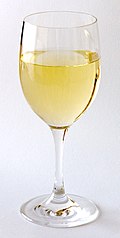 |  | |
| Wine glasses of white (left) and red wine (right) | ||


Wine is an alcoholic beverage, made of fermented fruit juice, usually from grapes.[1] The natural chemical balance of grapes lets them ferment without the addition of sugars, acids, enzymes, or other nutrients.[2] Grape wine is produced by fermenting crushed grapes using various types of yeast. Yeast consumes the sugars in the grapes and converts them into alcohol. Different varieties of grapes and strains of yeasts produce different types of wine.
Wines made from other fruits, such as apples and berries, are normally named after the fruit from which they are produced (for example, apple wine or elderberry wine) and are generically called fruit wine or country wine (not to be confused with the French term vin de pays). Others, such as barley wine and rice wine (i.e., sake), are made from starch-based materials and resemble beer and spirit more than wine, while ginger wine is fortified with brandy. In these cases, the term "wine" refers to the higher alcohol content rather than the production process.[3] The commercial use of the English word "wine" (and its equivalent in other languages) is protected by law in many jurisdictions.[4]
Wine has a rich history dating back thousands of years, with the earliest known production occurring around 8,000 years ago on the territory of modern-day Georgia.[5][6] It first appeared in the Balkans at about 4500 BC and was very common in ancient Greece, Thrace and Rome. Wine has also played an important role in religion throughout history. The Greek god DionysusRoman equivalent Bacchus represented wine, and the drink is also used in ChristianEucharist ceremonies and the Jewish Kiddush. and the
Contents[hide]
|
[edit] Etymology
The English word "wine" comes from the Proto-Germanic "*winam," an early borrowing from the Latin vinum, "wine" or "(grape) vine," itself derived from the Proto-Indo-European stem *win-o- (cf. Hittite: wiyana, Lycian: Oino, Ancient Greek οῖνος - oînos, Aeolic Greek ϝοίνος - woinos).[7][8]
The earliest attested terms referring to wine are the Mycenaean Greek me-tu-wo ne-wowo-no-wa-ti-si meaning "wine garden", written in Linear B inscriptions.[9][10][11][12] meaning "the month of new wine" or "festival of the new wine" and
Although no clear evidence has been found of any linguistic connection, some scholars have noted the similarities between the words for wine in the Kartvelian (e.g. Georgian ღვინოɣvino), Indo-European languages (e.g. Russian vino), and Semitic (*wayn), hinting to the possibility that this word diffused into all these language families from a common origin.[13][14] Some Georgian scholars have speculated that Georgian was the origin of this word and that it entered into the Indo-European languages via Semitic.
[edit] History
Archaeological evidence suggests that the earliest known production of wine, made by fermenting grapes, took place as early as 8,000 years ago in Georgia[5] and 6,100 years ago in Armenia.[6][15][16] These locations are all within the natural area of the European grapevine Vitis vinifera.

Through an extensive gene-mapping project in 2006, Dr. McGovern and his colleagues analyzed the heritage of more than 110 modern grape cultivars, and narrowed their origin to a region in Georgia, where also wine residues were discovered on the inner surfaces of 8,000-year-old ceramic storage jars in Shulavari, Georgia.[17] Other notable areas of wine production have been discovered in Greece and date back to 4500 BC.[16][18][19][20] The same sites also contain the world's earliest evidence of crushed grapes.[18] On January 11, 2011 in one of Armenia's Vayots Dzor province cave was found a wine making press dating to approximately 6,000 years ago.[16][20][21] Literary references to wine are abundant in Homer (9th century BC, but possibly composed even earlier), Alkman (7th century BC), and others. In Ancient Egypt, six of 36 wine amphoras were found in the tomb of King Tutankhamun bearing the name "Kha'y", a royal chief vintner. Five of these amphoras were designated as from the King's personal estate with the sixth listed as from the estate of the royal house of Aten.[22] Traces of wine have also been found in central Asian Xinjiang, dating from the second and first millennia BC.[23]
The first known mentioning of grape-based wines in India was in the late 4th century BC writings of Chanakya who was the chief minister of Emperor Chandragupta Maurya. In his writings, Chanakya condemns the use of alcohol while chronicling the emperor and his court's frequent indulgence of a style of grape wine known as Madhu.[24]
A 2003 report by archaeologists indicates a possibility that grapes were mixed with rice to produce mixed fermented beverages in China in the early years of the seventh millennium BC. Pottery jars from the Neolithic site of Jiahu, Henan contained traces of tartaric acid and other organic compounds commonly found in wine. However, other fruits indigenous to the region, such as hawthorn, cannot be ruled out.[25][26] If these beverages, which seem to be the precursors of rice wine, included grapes rather than other fruits, these grapes were of any of the several dozen indigenous wild species of grape in China, rather than from Vitis vinifera, which were introduced into China some 6000 years later.[25]
One of the lasting legacies of the ancient Roman Empire was the viticulture foundation the Romans laid in the lands that today are world renowned wine regions. Areas with Roman garrison towns, like Bordeaux, Trier, and Colchester, the Romans planted vineyards to supply local needs and limit the cost of long distance trading.[27] In medieval Europe, the Roman Catholic Church staunchly supported wine, since they required it for the Mass. Monks in France made wine for years, aging it in caves.[28] An old English recipe that survived in various forms until the 19th century calls for refining white wine from bastard—bad or tainted bastardo[29] wine.
[edit] Grape varieties
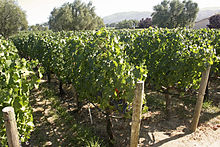
Wine is usually made from one or more varieties of the European species Vitis vinifera, such as Pinot Noir, Chardonnay, Cabernet Sauvignon, Gamay and Merlot. When one of these varieties is used as the predominant grape (usually defined by law as a minimum of 75% or 85%), the result is a varietal, as opposed to a blended, wine. Blended wines are not necessarily considered inferior to varietal wines; some of the world's most expensive wines, from regions like Bordeaux and the Rhone Valley, are blended from different grape varieties of the same vintage.[citation needed]
Wine can also be made from other species of grape or from hybrids, created by the genetic crossing of two species. Vitis labrusca (of which the Concord grape is a cultivar), Vitis aestivalis, Vitis rupestris, Vitis rotundifolia and Vitis riparia are native North American grapes usually grown to eat fresh or for grape juice, jam, or jelly, but sometimes made into wine.
Hybridization is different from grafting. Most of the world's vineyards are planted with European V. vinifera vines that have been grafted onto North American species rootstock. This is common practice because North American grape species are resistant to phylloxera, a root louse that eventually kills the vine. In the late 19th century, most of Europe's vineyards (only excluding some of the driest vineyards in Southern Europe) were devastated by the bug, leading to massive vine deaths and eventual replanting. Grafting is done in every wine-producing country of the world except for Argentina, the Canary Islands and Chile—the only countries not yet exposed to the insect.[30]
In the context of wine production, terroir is a concept that encompasses the varieties of grapes used, elevation and shape of the vineyard, type and chemistry of soil, climate and seasonal conditions, and the local yeast cultures. The range of possibilities here can result in great differences between wines, influencing the fermentation, finishing, and aging processes as well. Many wineries use growing and production methods that preserve or accentuate the aroma and taste influences of their unique terroir.[31] However, flavor differences are not desirable for producers of mass-market table wine or other cheaper wines, where consistency is more important. Such producers try to minimize differences in sources of grapes through production techniques such as micro-oxygenation, tannin filtration, cross-flow filtration, thin film evaporation, and spinning cones.[32]
[edit] Classification
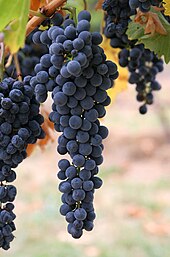
Regulations govern the classification and sale of wine in many regions of the world. European wines tend to be classified by region (e.g. Bordeaux, Rioja and Chianti), while non-European wines are most often classified by grape (e.g. Pinot Noir and Merlot). More and more, however, market recognition of particular regions is leading to their increased prominence on non-European wine labels. Examples of non-European recognized locales include Napa ValleyCalifornia, Willamette Valley in Oregon, Columbia Valley in Washington, Barossa Valley and Hunter Valley in Australia, Central Valley in Chile, Vale dos Vinhedos in Brazil, Hawke's BayMarlborough in New Zealand, Okanagan Valley and Niagara Peninsula in Canada. in and
Some blended wine names are marketing terms, and the use of these names is governed by trademark law rather than by specific wine laws. For example, Meritage (sounds like "heritage") is generally a Bordeaux-style blend of Cabernet Sauvignon and Merlot, and may also include Cabernet Franc, Petit Verdot, and Malbec. Commercial use of the term "Meritage" is allowed only via licensing agreements with an organization called the "Meritage Association".
[edit] European classifications
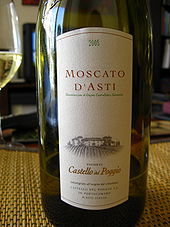
France has various appellation systems based on the concept of terroir, with classifications ranging from Vin de Table ("table wine") at the bottom, through Vin de Pays and Appellation d'Origine Vin Délimité de Qualité Supérieure (AOVDQS) up to Appellation d'Origine Contrôlée[33][34] Portugal has something similar and, in fact, pioneered this technique in 1756 with a royal charter that created the "Demarcated Douro Region" and regulated wine production and trade.[35] Germany did likewise in 2002, although their system has not yet achieved the authority of those of the other countries'.[36][37] Spain, Greece and Italy have classifications based on a dual system of region of origin and product quality.[38] (AOC) or similar, depending on the region.
[edit] Beyond Europe
New World wine—wines from outside of the traditional wine growing regions of Europe tend to be classified by grape rather than by terroir or region of origin, although there have been non-official attempts to classify them by quality.[39][40]
[edit] Vintages
A "vintage wine" is one made from grapes that were all or mostly grown in a particular year, and labeled as such. Most countries allow a vintage wine to include a portion that is not from the labeled vintage. Variations in a wine's character from year to year can include subtle differences in color, palate, nose, body and development. High-quality wines can improve in flavor with age if properly stored.[1] Consequently, it is not uncommon for wine enthusiasts and traders to save bottles of an especially good vintage wine for future consumption.
In the United States, for a wine to be vintage dated and labeled with a country of origin or American Viticultural Area (AVA) (such as "Sonoma Valley"), it must contain at least 95% of its volume from grapes harvested in that year.[41] If a wine is not labeled with a country of origin or AVA the percentage requirement is lowered to 85%.[41]
Vintage wines are generally bottled in a single batch so that each bottle will have a similar taste. Climate can have a big impact on the character of a wine to the extent that different vintages from the same vineyard can vary dramatically in flavor and quality.[42] Thus, vintage wines are produced to be individually characteristic of the vintage and to serve as the flagship wines of the producer. Superior vintages, from reputable producers and regions, will often fetch much higher prices than their average vintages. Some vintage wines, like Brunellos, are only made in better-than-average years.
For consistency, non-vintage wines can be blended from more than one vintage, which helps wine makers sustain a reliable market image and maintain sales even in bad years.[43][44] One recent study suggests that for normal drinkers, vintage year may not be as significant to perceived wine quality as currently thought, although wine connoisseurs continue to place great importance on it.[45]
[edit] Tasting
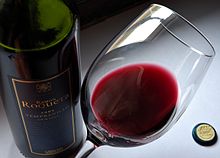
Wine tasting is the sensory examination and evaluation of wine. Wines are made up of chemical compounds similar or identical to those in fruits, vegetables, and spices. The sweetness of wine is determined by the amount of residual sugar in the wine after fermentation, relative to the acidity present in the wine. Dry wine, for example, has only a small amount of residual sugar.
Individual flavors may also be detected, due to the complex mix of organic molecules such as esters and terpenes that grape juice and wine can contain. Experienced tasters can distinguish between flavors characteristic of a specific grape and flavors that result from other factors in wine making. Typical intentional flavor elements in wine are those imparted by aging in oak casks; chocolate, vanilla, or coffee almost always come from the oak and not the grape itself.[46]
Banana flavors (isoamyl acetate) are the product of yeast metabolism, as are spoilage aromas such as sweaty, barnyard, band-aid (4-ethylphenol and 4-ethylguaiacol),[47] and rotten egg (hydrogen sulfide).[48] Some varietals can also have a mineral flavor due to the presence of water-soluble salts (like limestone).
Wine aroma comes from volatile compounds in the wine that are released into the air.[49]Chinon and Beaujolais, many people prefer them chilled.[50] Vaporization of these compounds can be sped up by twirling the wine glass or serving the wine at room temperature. For red wines that are already highly aromatic, like
[edit] Collecting

Outstanding vintages from the best vineyards may sell for thousands of dollars per bottle, though the broader term fine wine covers bottles typically retailing at over about US$30–50.[51] "Investment wines" are considered by some to be Veblen goods—that is, goods for which demand increases instead of decreases as its price rises. The most common wines purchased for investment include those from Bordeaux, Burgundy, cult wines from Europe and elsewhere, and Vintage port. Characteristics of highly collectible wines include:
- A proven track record of holding well over time
- A drinking window plateau (i.e., the period for maturity and approachability) that is many years long
- A consensus amongst experts as to the quality of the wines
- Rigorous production methods at every stage, including grape selection and appropriate barrel-aging
Investment in fine wine has attracted fraudsters who prey on their victims' ignorance of this sector of the wine market.[citation needed] Wine fraudsters often work by charging excessively high prices for off-vintage or lower-status wines from famous wine regions, while claiming that they are offering a sound investment unaffected by economic cycles.[citation needed] Like any investment, proper research is essential before investing.